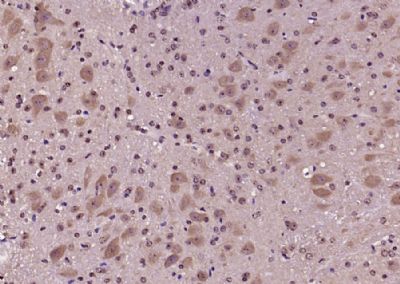KLK9 Polyclonal Antibody
Purified Rabbit Polyclonal Antibody (Pab)
- SPECIFICATION
- CITATIONS
- PROTOCOLS
- BACKGROUND

Application
| IHC-P, IHC-F, IF, E |
|---|---|
| Primary Accession | Q9UKQ9 |
| Reactivity | Rat |
| Host | Rabbit |
| Clonality | Polyclonal |
| Calculated MW | 26 KDa |
| Physical State | Liquid |
| Immunogen | KLH conjugated synthetic peptide derived from human KLK9 |
| Epitope Specificity | 51-150/250 |
| Isotype | IgG |
| Purity | affinity purified by Protein A |
| Buffer | 0.01M TBS (pH7.4) with 1% BSA, 0.02% Proclin300 and 50% Glycerol. |
| SUBCELLULAR LOCATION | Secreted (Probable). |
| SIMILARITY | Belongs to the peptidase S1 family. Kallikrein subfamily.Contains 1 peptidase S1 domain. |
| Important Note | This product as supplied is intended for research use only, not for use in human, therapeutic or diagnostic applications. |
| Background Descriptions | Kallikrein 9, also known as Kallikrein-Like 3 (KLK-L3), is a chymotrypsin-like serine proteinase. Kallikrein 9 was discovered as the locus for kallikreins on chromosome 19 was more fully mapped and found by similarity to the other tissue kallikreins. Kallikrein 9 has been found in the ovary, thymus, testis, prostate, skin, breast and neuronal tissues and is made by many cell lines in culture. Kallikrein 9 levels in breast cancer and uterine cancer patients have been reported to drop as the disease progresses, thus hK9 might be considered a favorable prognostic marker. Different splice variants of hK9 have been reported, although it is not yet known if they produce functional proteins. The full length Kallikrein 9 encodes for a 250 amino acid protein, with a predicted mass of 27.5 kDa and a pI of 7.53. The 234 amino acid form predicts a protein of 26 kDa with a pI of 9.76 and this quite basic pI might give the shorter form a very different function or localization. The shorter sequence also diverges before the catalytic serine residue, making it unlikely to be proteolytically active. Pre-pro-kallikrein 9 has the 17 amino acid signal sequence is removed before secretion, and the Pro-kallikrein 9 is activated to Kallikrein 9 by removal of the 5 amino acid propeptide domain. |
| Gene ID | 284366 |
|---|---|
| Other Names | Kallikrein-9, 3.4.21.-, Kallikrein-like protein 3, KLK-L3, KLK9 |
| Target/Specificity | Skin, thymus, trachea, cerebellum and spinal cord. |
| Dilution | IHC-P=1:100-500,IHC-F=1:100-500,IF=1:100-500,ELISA=1:5000-10000 |
| Format | 0.01M TBS(pH7.4), 0.09% (W/V) sodium azide and 50% Glyce |
| Storage | Store at -20 ℃ for one year. Avoid repeated freeze/thaw cycles. When reconstituted in sterile pH 7.4 0.01M PBS or diluent of antibody the antibody is stable for at least two weeks at 2-4 ℃. |
| Name | KLK9 |
|---|---|
| Cellular Location | Secreted. |
| Tissue Location | Skin, thymus, trachea, cerebellum and spinal cord. |

Thousands of laboratories across the world have published research that depended on the performance of antibodies from Abcepta to advance their research. Check out links to articles that cite our products in major peer-reviewed journals, organized by research category.
info@abcepta.com, and receive a free "I Love Antibodies" mug.
Provided below are standard protocols that you may find useful for product applications.
If you have used an Abcepta product and would like to share how it has performed, please click on the "Submit Review" button and provide the requested information. Our staff will examine and post your review and contact you if needed.
If you have any additional inquiries please email technical services at tech@abcepta.com.













 Foundational characteristics of cancer include proliferation, angiogenesis, migration, evasion of apoptosis, and cellular immortality. Find key markers for these cellular processes and antibodies to detect them.
Foundational characteristics of cancer include proliferation, angiogenesis, migration, evasion of apoptosis, and cellular immortality. Find key markers for these cellular processes and antibodies to detect them. The SUMOplot™ Analysis Program predicts and scores sumoylation sites in your protein. SUMOylation is a post-translational modification involved in various cellular processes, such as nuclear-cytosolic transport, transcriptional regulation, apoptosis, protein stability, response to stress, and progression through the cell cycle.
The SUMOplot™ Analysis Program predicts and scores sumoylation sites in your protein. SUMOylation is a post-translational modification involved in various cellular processes, such as nuclear-cytosolic transport, transcriptional regulation, apoptosis, protein stability, response to stress, and progression through the cell cycle. The Autophagy Receptor Motif Plotter predicts and scores autophagy receptor binding sites in your protein. Identifying proteins connected to this pathway is critical to understanding the role of autophagy in physiological as well as pathological processes such as development, differentiation, neurodegenerative diseases, stress, infection, and cancer.
The Autophagy Receptor Motif Plotter predicts and scores autophagy receptor binding sites in your protein. Identifying proteins connected to this pathway is critical to understanding the role of autophagy in physiological as well as pathological processes such as development, differentiation, neurodegenerative diseases, stress, infection, and cancer.


